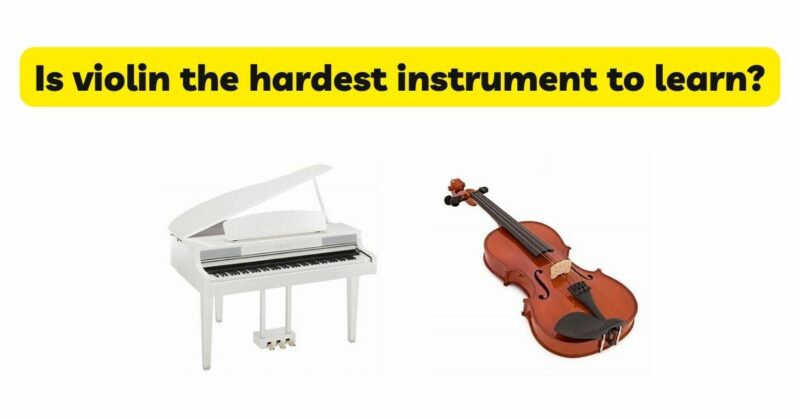Among the vast array of musical instruments, the violin often carries a reputation for being one of the most challenging to learn. The intricate techniques, physical demands, and meticulous attention to detail required can pose significant hurdles for aspiring violinists. However, labeling the violin as the “hardest” instrument to learn is subjective and fails to acknowledge the unique challenges associated with each instrument. In this article, we will delve into the complexities of learning the violin, examining factors such as technical demands, physicality, intonation, and expressiveness. By gaining a deeper understanding of the challenges faced by violinists, we can appreciate the dedication and perseverance required to master this captivating instrument.
- Technical Demands and Complexity: The technical demands and complexity of the violin are undeniable. From the precise finger placement on the fingerboard to the intricate bowing techniques, the instrument demands an exceptional level of coordination and dexterity. Developing the ability to shift smoothly between positions, execute rapid string crossings, and produce a consistent and controlled sound requires dedicated practice. The violin’s lack of frets or keys means that intonation is entirely reliant on the player’s ear, making it essential to develop a sensitive and accurate sense of pitch. Furthermore, mastering techniques such as vibrato, spiccato, and double stops adds an extra layer of complexity to the technical demands of the instrument.
- Physicality and Instrumental Technique: The physicality required to play the violin is both unique and demanding. Holding the violin against the shoulder, chin, and collarbone, while simultaneously manipulating the bow and placing the fingers precisely on the fingerboard, requires a well-developed sense of balance and body control. The instrument’s small size and light weight demand a delicate touch, and players must develop a relaxed bowing arm and hand position to produce a rich and resonant sound. Additionally, the left hand must develop finger strength, flexibility, and dexterity to execute rapid shifts and challenging finger patterns. The physicality of the violin is a significant challenge that aspiring violinists must overcome through consistent practice and attention to technique.
- Intonation and Ear Training: Intonation is a critical aspect of violin playing, and developing a keen ear for pitch is essential. Without the visual cues of frets or keys, violinists must rely on their ability to accurately produce and adjust pitches. This requires a heightened sense of listening, as well as a strong understanding of musical intervals and tonal relationships. The process of training the ear to distinguish and correct intonation is a continuous journey for violinists, requiring focused practice and a commitment to developing a precise and accurate sense of pitch.
- Expressiveness and Musical Interpretation: The violin is renowned for its ability to mimic the human voice and convey a wide range of emotions. However, this expressiveness adds an additional layer of challenge to the learning process. Mastery of bow control, articulation, and dynamics is crucial for effectively conveying musical phrasing and nuances. The ability to produce a rich, singing tone and evoke a variety of emotions through the instrument requires a deep understanding of musical interpretation and a strong connection between the player and the music. Developing a personal and artistic voice on the violin is a lifelong pursuit that demands continuous exploration and growth.
- Learning Curve and Patience: The learning curve associated with the violin can be steep, particularly in the early stages of learning. Developing the fundamentals of bowing technique, left-hand coordination, and intonation requires consistent and focused practice. Unlike instruments with more immediate visual cues, the violin demands a higher level of sensory awareness, relying on tactile and aural feedback. Learning to produce a pleasing sound on the violin can take time and patience, and progress may seem slow in the initial stages. However, with perseverance and a disciplined approach, violinists can gradually unlock the instrument’s vast potential.
- Personal Motivation and Passion: Learning the violin requires a high level of personal motivation and passion. The challenges encountered on the journey of mastering the instrument can be overwhelming without a strong intrinsic drive. Diligent practice, perseverance, and a commitment to growth are essential to navigate the difficulties and maintain progress. As with any instrument, the motivation to conquer the challenges of the violin stems from a genuine love for the instrument and a desire to express oneself musically.
Conclusion: While the violin presents a myriad of challenges that can make it a demanding instrument to learn, it is important to recognize that the perception of difficulty is subjective and varies among individuals. The technical demands, physicality, intonation requirements, and expressiveness of the violin contribute to its reputation as a challenging instrument. However, this should not discourage aspiring violinists from embarking on this captivating musical journey. With dedicated practice, guidance from a skilled instructor, and a deep passion for music, the challenges can be overcome, leading to a rewarding and fulfilling experience. The violin’s unparalleled expressiveness and the ability to convey emotions through its ethereal tones make it a unique and captivating instrument, justifying the commitment required to master its intricacies. Embrace the challenges, cherish the journey, and allow the enchanting sound of the violin to guide you on a path of musical discovery.


